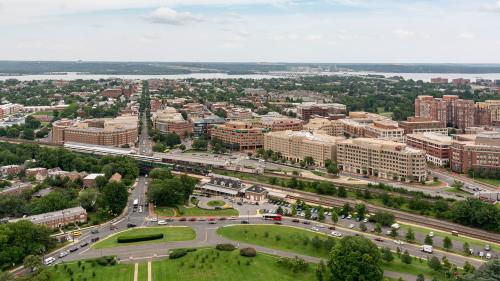The Washington, D.C., metropolitan region, known as the DMV — District, Maryland, and Virginia — is home to the U.S. federal government, 6.4 million people, and hundreds of thousands of private sector jobs. To track the cascading impacts of federal restructuring and national policy shifts, Brookings has launched the DMV Monitor. Joining The Current to introduce the DMV Monitor are two of the researchers behind this crucial effort, Tracy Hadden Loh, a fellow in Brookings Metro, and Glencora Haskins, research associate and applied research manager at Brookings Metro.
Transcript
LOH: What we see in the early data is that, look, the region’s got 3 million jobs, and so whether 10,2000 or 20,000 of them stay or go may sound like a drop in the bucket on the federal side, but what we’re seeing is that it’s adding up to impacts on the private sector as well, and that job growth in the region has stalled even as it remains positive nationwide.
[music]
DEWS: Hi, I’m Fred Dews, and this is The Current, part of the Brookings Podcast Network.
On this episode, I’m turning our attention to the Washington, D.C., metropolitan area, also known as the DMV, District, Maryland, and Virginia, home of the federal government, 6.4 million people, and which has been experiencing significant economic turmoil due to the downsizing of the federal government. For example, since January 2025, the region’s unemployment rate has risen at a higher pace than the rest of the nation.
To track the complex and cascading impacts of federal restructuring and national policy shifts, Brookings has just launched the DMV Monitor, which you can find on our website at Brookings dot edu slash DMV dash Monitor.
Joining me now are two of the researchers behind this crucial effort, Tracy Hadden Loh, a fellow in Brookings Metro, and Glencora Haskins, research associate and applied research manager at Brookings Metro.
Tracy, welcome to The Current.
LOH: Thanks for having us, Fred.
DEWS: And Glencora, welcome to The Current as well.
HASKINS: Thank you so much for having me.
DEWS: So Tracy, what is the DMV Monitor and why is Brookings launching it now?
[1:33]
LOH: The DMV Monitor is an ongoing project to track the evolution of the country’s sixth largest regional economy. And we are doing this because Brookings has a long history of caring about the strength of regional economies, which add up to the strength of the national economy. But also because the DMV is the home of Brookings. Everyone who works at this institution lives in this region. And, it is really meaningful, I think, for all of us here to be doing something at the institution to give back to the place that is our home.
DEWS: Yeah, I remember when Brookings Metro first started, there was a Greater Washington Research Program and Brookings Metro kind of joined with that, many years ago. So Brookings has had a long, long experience with the Washington, D.C., region.
LOH: And Brookings has had some incredible impact on the region, through that initiative. I remember that program did a report called “A Region Divided,” that when I go around the region now in my work locally, I still hear about that report all the time. You know, most reports are just like a PDF that disappears online and you don’t necessarily know if anybody reads it. For something like that to be such a conversation changer, that is the kind of impact we’re hoping to have with the DMV Monitor.
DEWS: So the DMV monitor tracks seven key aspects of the regional economy. Glencora, can you quickly review what those areas are?
[2:59]
HASKINS: Absolutely. So when we were picking components of the regional economy to highlight in the DMV monitor, we wanted to focus on both the acute economic impacts on the region, but also longer term impacts on both the people, households, and workers that live and commute into the region every day.
So that includes typical economic metrics like economy and workforce, but also longer term impacts on things like housing, innovation, and productive capital, destination travel metrics including hotel revenue, municipal services, and the overall health and wellbeing of households.
DEWS: And you both, along with our former colleague Amy Liu, who formerly led Brookings Metro for many years, published a piece on our website about what you called quote “early warning signs” for the region. What are these early warning signs?
[3:47]
LOH: So, there’s a lot going on that’s affecting the country as a whole. Right? Not just tariffs, but for example, changes to SNAP and Medicaid. Right? Those will have impacts in places across the country. But there’s also a lot of unique stuff that’s just happening in the DMV relating to the restructuring of the federal government and impacts on industries that have big representation in the private sector here, like defense and biomedical research.
So what we see in the early data is that, look, the region’s got 3 million jobs and so whether 10,000 or 20,000 of them stay or go may sound like a drop in the bucket, on the federal side. But what we’re seeing is that it’s adding up to impacts on the private sector as well, and that job growth in the region has stalled even as it remains positive nationwide.
DEWS: Glencora, can you expand a little bit on how the research is done? How do you gather this data and then what do you do with it?
[4:43]
HASKINS: Absolutely. So we primarily use federal data sets to measure these high level economic metrics that includes overall job counts and unemployment growth. Importantly, job counts are measured at the place of employment while unemployment is captured at the place of residence. The reason why that’s relevant here is because it underscores the interconnectedness of the regional economy and how much workers that live in Maryland and Virginia in our suburban counties rely on the health and wellbeing of D.C.’s economy for their own prosperity and welfare.
So we collect these data from federal resources and synthesize them together. Then we use small area estimation to make sure that we are accounting for the disparate impacts across the regions’ different suburbs and suburban counties across D.C., Maryland, and Virginia.
[5:31]
LOH: We’re also doing some really cool stuff with private data. So for example, the government’s shut down right now, and so we actually don’t even have access to government data. But we’re doing stuff like gathering data from job posting websites, from commercial real estate listing services so that we can in real time get visibility into what’s happening in the private sector and how it compares to what’s happening in other regions throughout the country.
So we’re looking not just at the DMV, but actually at over 50 major metro areas around the country to place the DMV in context and to understand, hey, what are these trends? Are they big or not?
DEWS: Okay. So just to clarify, the data in the DMV Monitor about the District, Maryland, and Virginia are also compared against metrics from these 50 other metro areas and people can see that when they’re on the DMV Monitor?
HASKINS: Yes, absolutely. You can compare it against all of the constituent counties within the DMV as well as the other 54 metro areas in the U.S. with more than one million people.
DEWS: I want to go back to the early warning science piece, because you wrote in that piece, quote, “the White House’s drive to transform the federal government is likely to stick and even expand over time.” But could a new presidential administration in the future, if it wanted to, reverse those those changes in the federal workforce?
[6:50]
HASKINS: So a future administration could certainly make efforts to recapture some of the jobs that were lost in the federal sector. But like Tracy was saying, layoffs in this area have widespread impacts on the private sector as well. Those jobs are unlikely to come back with instantaneous policy shifts by a new administration. It’s much easier to erase job growth than it is to recapture it.
LOH: Yeah, I think generally speaking, the private sector responds to increased uncertainty by trying to, you know, decrease exposure and risk. And so what we’re seeing is a slowdown in hiring and in venture capital flow to the DMV that even though, you know, those metrics are still positive in other metro areas around the country. A future administration, you know, deciding they want to turn the spigot back on, there isn’t, like, a magic switch that you can flip to say like, no, I am trustworthy, I will pay my bills, and I’m a good customer. Right? Trust is something that you have to earn over time.
DEWS: Can you expand a little bit on that point about venture capital flow? What does that mean?
[7:55]
LOH: So, for example, there’s this really cool company in Prince George’s County, they make a form of, like, a liquid bandage. It’s it’s almost like a replacement skin. Right? It’s a really cool idea, sort of obvious, like, you know, application to, you know, to real world problems. And that company is actually a spinoff of, like, a technology that was developed at the University of Maryland, which is why it’s at a company that’s based near the campus.
So an idea like that comes about because there’s federally sponsored research happening at a state institution. And then the idea gets commercialized. And in order to commercialize it, private money from what’s called venture capital needs to be invested in the company to help them turn the idea from something that’s feasible in a lab to something that is commodifiable in the real world. Right? It takes a lot of money to walk the idea that much further down the road.
And so that company seeks venture capital in order to get investment in their idea so that everyone who invests in it now can benefit downstream when it’s a sellable idea that’s on shelves and hospitals nationwide.
DEWS: So my understanding is that the DMV Monitor is releasing new data this week on the racial demographics of the federal downsizing, and in particular about African American workers in the region. What is that data showing?
[9:22]
HASKINS: So what our new data on unemployment by race is showing is that while impacts are starting to become better understood about federal layoffs nationwide, that the federal workforce is more diverse in the private sector, and therefore layoffs in the federal sector are disproportionately harming workers of color.
We see that reflected in the unemployment rate. Unemployment rates for Black workers and workers of color overall are going up nationally. They’re also going up in the DMV, but not as much, which is interesting, especially considering that particularly in the District of Columbia unemployment has long been higher than the nation overall, even though that’s not true for the region. The region has long enjoyed a lower unemployment rate than the United States writ large.
In D.C., we actually see the unemployment rate for Black workers going down. That is something that is completely unprecedented in times of economic turmoil. Historically, Black workers and workers of color are considered to be the first fired, last hired in times of economic distress.
What remains unknown is how much this trend will stick after data for October comes out and we see the long-term impacts of deferred resignations.
[10:28]
LOH: I think another huge question mark is that even though what we’re seeing locally in the DMV is that white unemployment is up more than Black unemployment, in other words that, like, the federal layoffs and what’s happening in the private sector are hitting workers across all racial demographic categories, that doesn’t mean that all of those workers will have the same experience attempting to reenter the workforce, right? after job loss.
And one of the reasons why we want the DMV Monitor to be an ongoing project is so that we can continue to disaggregate these metrics over time and to see what the cumulative impact of the policies that are being put in place are.
DEWS: Are there any, positive signs in any of the data that you’re seeing?
[11:13]
LOH: Yeah, I mean, I think the key takeaway for me of seeing the DMV compared to other metro areas around the country is that this region, it’s not perfect, but historically it’s very strong: lower unemployment than other metro areas, really high productivity, better credit, lower crime. This is a place with really high quality of life and a really strong economy, and the fundamentals are awesome.
Right now there are all of these troubling trends that are I think a challenge to that historic strength. But that means that the region has a lot of assets that it can rely on in order to respond to what’s happening and to adapt.
[12:00]
HASKINS: Yeah. I would just second exactly what Tracy said. We see this region as a very strong place to live and work that is obviously struggling with some of the impacts of federal downsizing but nonetheless showing its resilience and strength. The DMV is one of the highest educated metros in the country, just behind San Jose and the Silicon Valley. Workers here have higher credit scores and are more credit worthy when it comes to lending, buying, and home ownership.
And we don’t want to see those trends continue to decrease to the point where they fall below the national average. But it’s really important to note that as we see these metrics decline, this region is still at a healthier baseline than several other of its peers.
DEWS: So that story suggests to me that even though the DMV is the seat of the national government of the United States, people have often said that the city is dependent upon the federal government, it actually may not be through these various qualities, these strengths that you’ve talked about.
[13:02]
LOH: Well, I would actually put it to you the other way. That the federal government and its functioning depends on the strong characteristics. Like, wouldn’t we want the federal government to be located in a region with a highly educated workforce, low crime, high quality of life? Right? Like, you know, that’s a great place to put the foundations of national defense and biomedical research. Right? Those are inputs to production for those things.
And if we want a federal government that delivers for the country on its mission, then I would argue that those are necessary ingredients. And so the question is now there’s a renegotiation happening between how the federal government sees its role and what it needs from the region.
And all all I would say is I would like to see a robust conversation and multiple stakeholders come to the table in order to figure out what a new, optimal normal might be like as opposed to a singular vision that isn’t necessarily a productive vision.
[14:10]
HASKINS: Right. There are plenty of regional examples of economies being able to diversify away from one economic anchor in the long run. Right? Countless of Washington, D.C.’s peers have made that effort in eras of de-industrialization or collapses of other historical legacy industry clusters. That could very well happen with the DMV as well, and the economy could enjoy diversification away from federal employment, which has such a large foothold here.
But there’s no historical context for that happening organically and with dismissiveness by local and regional leaders. So if this economy is going to survive and thrive in the long term, we need leaders from D.C., Maryland, and Virginia to all acknowledge that this is a problem and be willing to work together to find solutions, particularly around private sector growth. Otherwise, we’re going to see the impacts of federal downsizing be much worse and much longer term.
DEWS: Okay, we’ll leave it there. Tracy, Glencora, thanks for spending your time with me today.
LOH: Thanks for having us, Fred.
[music]
HASKINS: Thank you so much.
To learn more about Glencora Haskins, Tracy Hadden Loh, and the DMV Monitor, visit the Brookings website, Brookings dot edu slash DMV dash Monitor.
More information:
- Listen to The Current on Apple, Spotify, YouTube, or wherever you like to get podcasts.
- Learn about other Brookings podcasts from the Brookings Podcast Network.
- Sign up for the podcasts newsletter for occasional updates on featured episodes and new shows.
- Send feedback email to [email protected].
The Brookings Institution is committed to quality, independence, and impact.
We are supported by a diverse array of funders. In line with our values and policies, each Brookings publication represents the sole views of its author(s).








Commentary
PodcastIs DC’s economy stalling? Insights from the DMV Monitor
Listen on
The Current Podcast
October 16, 2025